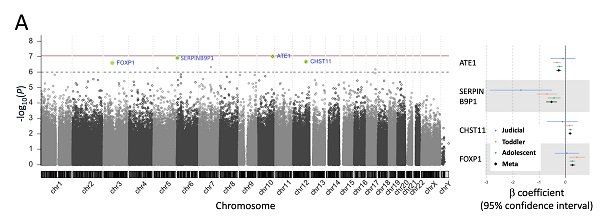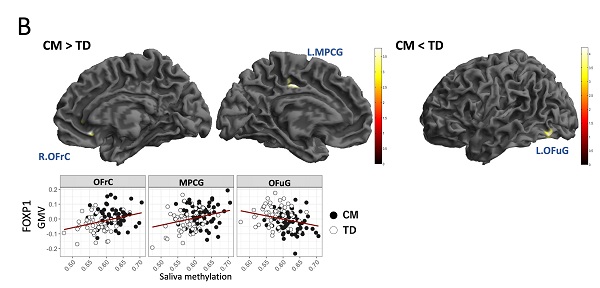Epigenetic “Scars”: Unveiling How Childhood Trauma Affects Our Genes
October 15, 2025
Epigenetic “Scars”: Unveiling How Childhood Trauma Affects Our Genes
Researchers identify molecular markers in children and adolescents, revealing how child maltreatment stress alters DNA, brain development, and mental health
Childhood trauma has often been linked to adverse mental health outcomes, but its impact on genetic changes often goes unnoticed. A new study at University of Fukui identified “epigenetic scars” in DNA, leading to structural alterations of brain regions related to emotional regulation, memory retrieval, and social cognition. Findings suggest that these biological markers may enable early detection, personalized treatment, and prevention of these effects—offering hope for breaking the intergenerational cycle of child abuse.
Child maltreatment, which includes abuse and neglect, is one of the most serious public health concerns worldwide. These adversities leave a lasting impact on the emotional well-being, memory, and social development of affected individuals. The problem, however, reaches far beyond its psychological impact, affecting the brain and biological processes through genetic changes, which have remained unclear until now.
A recent study led by Senior Asst. Professor Shota Nishitani and Professor Akemi Tomoda from the Research Center for Child Mental Development at University of Fukui, Japan, in collaboration with Professor Masataka Nagao from the Department of Forensic Medicine, Graduate School of Biomedical and Health Sciences, Hiroshima University, Japan, reveals that child maltreatment leaves measurable biological “scars” on children’s DNA, leading to long-term alterations in the brain. The findings of the study were published in Molecular Psychiatry on September 16, 2025.
Their research builds on earlier findings from Prof. Tomoda’s group, which had revealed that child maltreatment can alter DNA. Unlike previous studies that focused on specific candidate genes, this current work employed a broader genome-wide approach, revealing novel molecular markers and directly linking them to brain structure.
Briefly, the researchers conducted a detailed analysis of the epigenome (a set of chemical “switches” on our DNA that regulate gene activity) across three different groups to identify biological markers linked to childhood maltreatment as trauma. Participants included those in judicial autopsy cases, as well as toddlers and adolescents who had undergone protective interventions, with the adolescents also undergoing brain MRI scans.
“We identified four DNA methylation sites that were consistently associated with child maltreatment, namely ATE1, SERPINB9P1, CHST11, and FOXP1,” explains lead author, Senior Asst. Professor Nishitani.
DNA methylation sites are key players in genetic regulation, as they can regulate the gene expressions without changing the underlying DNA sequence. While the researchers identified four different sites, the site FOXP1 was particularly significant as it acts as a “master switch” for the genes involved in brain development. The researchers found that hypermethylation of FOXP1 was linked to changes in gray matter volume in the orbitofrontal cortex, cingulate gyrus, and occipital fusiform gyrus of the brain regions which are responsible for emotional regulation, memory retrieval, and social cognition. This highlights the biological link between early trauma, brain development, and later mental health outcomes.
“Childhood trauma is not only a painful psychological experience but also leaves lasting biological marks at the molecular and brain levels,” explains Prof. Tomoda. “By identifying these epigenetic markers, we hope to develop new tools that can enable the detection and support of at-risk children as early as possible.”
To use their discovery for predictive analysis, the researchers created a methylation risk score (MRS) using the four identified DNA methylation sites. The score could successfully distinguish individuals with and without a history of maltreatment using external data independent of their own, suggesting its potential as an objective screening tool for identifying childhood trauma.
The significance of this discovery extends to multiple fields, including healthcare, forensic medicine, and public health policies. In healthcare, these biomarkers could help improve early diagnosis and personalized trauma-informed treatment approaches. While in forensics, it could help support investigations and support child welfare. Furthermore, the screening tools may also drive preventive care, reducing the long-term societal impact of maltreatment.
With these implications, the study also reflects the mission of the Division of Developmental Support Research at the University of Fukui, which integrates neuroscience, clinical practice, and community-based approaches to promote resilience and well-being for children and families. The center is dedicated to advancing the science and practice of child development and mental health, and focuses on early detection, intervention, and prevention of developmental and mental health issues.
“Childhood should be a time of safety and growth,” emphasizes Prof. Tomoda. “Understanding how childhood trauma affects us biologically can lead to better strategies for prevention, treatment, and support, helping break the cycle of maltreatment.”

Manhattan plots for the meta-analysis (Left). The solid dark red line indicates genome-wide significance (P = 9.0 × 10⁻⁸), and the dashed gray line shows the suggestive significance threshold (P = 1.0 × 10⁻⁶). The four probes that reached q-value significance are highlighted in light green and labeled with their corresponding gene names. Forest plot for the four significant probes (Right). Error bars represent the SEM.

Upper panel: Whole-brain gray matter volume (GMV) comparison using voxel-based morphometry. The three identified brain regions are R.OFrC (right orbitofrontal cortex), L.MPCG (left medial/posterior cingulate gyrus), and L.OFuG (left occipital fusiform gyrus). Color bars indicate t-statistics. Lower panel: Correlation plots for FOXP1 with each of the GMV measures in these regions.
Reference
Title of original paper:Multi-epigenome-wide analyses and meta-analysis of child maltreatment in judicial autopsies and intervened children and adolescents
Journal:Molecular Psychiatry
DOI:10.1038/s41380-025-03236-1
About University of Fukui, Japan
The University of Fukui is a preeminent research institution with robust undergraduate and graduate schools focusing on education, medical and science, engineering, and global and community studies. The university conducts cutting-edge research and strives to nurture human resources capable of contributing to society on the local, national, and global level.
Website: https://www.u-fukui.ac.jp/eng/
About Senior Asst. Professor Shota Nishitani from University of Fukui, Japan (Fiscal year 2019–2023)
Shota Nishitani, (Ph.D.), served as an Assistant Professor (Fiscal year 2019–2021) and a Senior Assistant Professor (Fiscal year 2022–2023) at the Research Center for Child Mental Development, University of Fukui, Japan. Prior to this role, he gained four years of extensive experience in epigenome-wide association studies as a Visiting Assistant Professor at Emory University (Fiscal year 2015–2018). His research aims to unravel the neurobiological mechanisms underlying child maltreatment and trauma. He addresses these questions by integrating computational approaches, such as epigenetic and neuroimaging bioinformatics, with experimental molecular biology techniques. He is now continuing his career as a Research Scientist at the Department of Psychiatry and Behavioral Sciences, Stanford University School of Medicine.
About Professor Akemi Tomoda from University of Fukui, Japan
Akemi Tomoda, (M.D, Ph.D.), is a Professor and Director of the Division of Developmental Support Research at the Research Center for Child Mental Development, University of Fukui, Japan. Her areas of research interest include child psychiatry, neuroimaging of brain structure and function, attachment disorders, ADHD, and the effects of child maltreatment. Over her 35-year-long research career, she has published more than 140 peer-reviewed articles, along with multiple chapters, letters, and commentaries. Currently, her research focuses on child psychiatry, particularly on identifying the neurobiological and epigenetic consequences of child maltreatment.
Funding information
The study was supported by
1. Japan Agency for Medical Research and Development (AMED) (Grant JP20gk0110052)
2. Japan Society for the Promotion of Science (JSPS) KAKENHI Scientific Research (A) (Grant JP19H00617)
3. JSPS KAKENHI Scientific Research (C) (Grants JP20K02700, JP21K02352)
4. Strategic Budget to Realize University Missions, University of Fukui
5. Research Grants, University of Fukui (FY 2019 and 2020)
6. Life Science Innovation Center, University of Fukui – Grants for Translational Research and Creative & Innovative Research (LSI20305, LSI22202)
7. Grant for Life Cycle Medicine, Faculty of Medical Sciences, University of Fukui
Media contact:
University of Fukui PR center
sskoho-k※ad.u-fukui.ac.jp
Please change ※to@.
